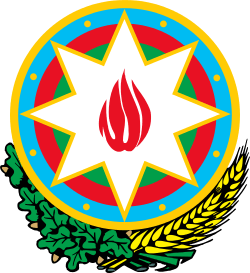Novruz in Azerbaijan
| Part of a series on |
| Azerbaijanis |
|---|
| Culture |
| Traditional areas of settlement |
| Diaspora |
| Religion |
| Language |
| Persecution |
|
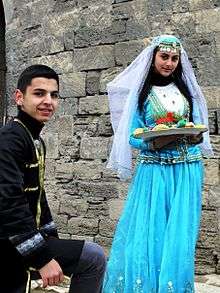
Novruz in Azerbaijan (Azerbaijani: Novruz Bayramı) is a traditional holiday, which celebrates the New Year, and the coming of Spring in Azerbaijan Republic and Iranian Azerbaijan. When North Azerbaijan was part of the Soviet Union, celebration of Novruz was generally unofficial, and at times even prohibited.[1] Currently in Azerbaijan, Novruz is treated as an official public holiday. In accordance with Article 105 of the Labour Code of Azerbaijan passed in 2006, workers receive five days off for Novruz.[2] After neighbouring Iran, Azerbaijan hosts the longest observance and amount of public days related to Novruz, with thus a total (including weekend) of 7 days.[3]
Novruz customs and celebration
Usually preparation for Novruz begins a month prior to the festival. Each of forthcoming 4 weeks is devoted to one of the four elements and called accordingly in Azerbaijan. Each Tuesday people celebrate the day of one of the four elements - water, fire, earth and wind.[4] People do house cleaning, plant trees, make new dresses, paint eggs, make national pastries such as shekerbura, pakhlava, shorgoghal and a great variety of national cuisine.[5] Wheat is fried with kishmish (raisins) and nuts (govurga). As a tribute to pre-Islamic Zoroastrian beliefs, every Tuesday during four weeks before the holiday kids jump over small bonfires and candles are lit. On the holiday eve the graves of relatives are visited and tended.[6]
Novruz is a family holiday. In the evening before the holiday the whole family gathers around the holiday table laid with various dishes to make the New Year rich. The holiday goes on for several days and ends with festive public dancing and other entertainment of folk bands, contests of national sports. In rural areas crop holidays are marked.[7]
The decoration of the festive table is khoncha, a big silver or copper tray with Samani, green shoots from wheat seeds placed in the centre and candles and dyed eggs by the number of family members around it. The table should be set, at least, with seven dishes.[4]
Gallery
-

A 1996 Azerbaijani postage stamp issued for Novruz
-

Traditional Azerbaijani Folk Performers
-

Medieval warriors near the Maiden Tower
-

Medieval warrior
-

-

Kosa that means a man with little or no beard,is a carnival character known to the medieval and modern folklore of Novruz[1]
-
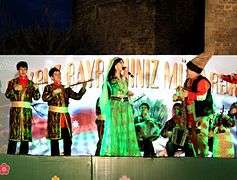
Nowruz Concert in Baku
-
Azerbaijani girl with Khoncha
-
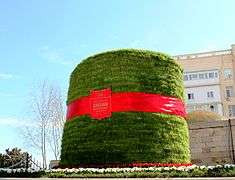
Giant Samani
-
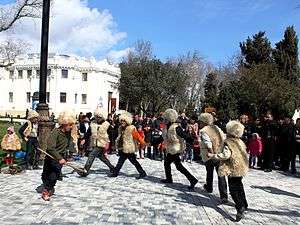
Azerbaijani kids dancing Shepherd dance
References
- ↑ Waters, Zena (April–May 2005), "What exactly is Novruz Bayram", Azerbaijan Today (12), retrieved 2009-03-22
- ↑ "Public Holidays in Azerbaijan" (PDF), Tax and Legal News, Deloitte Touche Tohmatsu, December 2006, retrieved 2009-03-22
- ↑ "Azerbaijan 2010 Bank Holidays". Bank-holidays.com. Retrieved 2010-04-06.
- 1 2 International Day of Nowruz- 21 March
- ↑ Azerbaijan marks Novruz holiday
- ↑ Azerbaijani traditions
- ↑ Studentsoftheworld - Azeri Traditions
